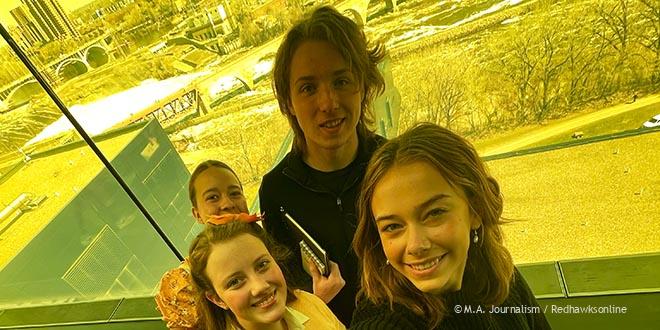On Wednesday, April 26, Minnehaha students junior Tennyson Shultz, first-year Gabi Jankowski, junior James Wilson, and I joined a small group of area school journalism students for a day at the Guthrie, sponsored and led by members of the Journalism Educators of Minnesota. Our objective was to learn about every stage of theater production, and, after viewing Hamlet, to craft a critical review. The day consisted of an in-depth tour of the theater, discussion with a Star Tribune theater critic, and a viewing of Shakespeare’s renowned play, Hamlet.
Entering the theater lobby, students met the people who would guide their tour and introduced themselves. The tour began in the rehearsal wing of the theater where rehearsals for the play Murder on the Orient Express were under way.
Moving from that wing, the group entered the prop department where the guides explained the process of making a set. First the director drafts an idea of the props they want and gives it to the prop department who often take a trip to their off-site warehouse to see if they have any similar pieces already on hand. If none are available, the process of developing a prop begins. Everything from paint, fabric, and 3D printing are used in this undertaking.
Although the small props are important, the stage forms the path the production takes. The Guthrie has three different stages of different sizes, and the director determines which one will best fit their play’s needs. Hamlet is held on the Wurtele Thrust Stage. The stage’s edge can shift in shape and size to accommodate the script. For the final part of the tour, students met with Rohan Preston, a Star Tribune theater critic. He shared anecdotes from his life, his path to becoming a theater critic, and advice for writing play reviews.
Preston moved to New York City from Puerto Rico when he was young and spent most of his time in libraries and museums. He learned to love critiquing art. An acquaintance of his suggested that he apply for a job as a theater critic so that he could explore different kinds of creative expression and get paid for it. Preston loved this career plan, and his English degree from Yale helped and complemented it well. “Every single thing we do is about story,” Preston shared during the pre-Hamlet discussion.
He emphasized that the theater is a community that expresses the needs, hopes, and problems of the community. Approaching his criticisms and reviews this way, he asks himself and his readers questions about community performances: Is this a timely piece? Should this production be revived or forgotten? Did this address an issue in the community?
So following Preston’s suggestions, the group of students entered the dimly lit theater, took their seats, retrieved their notepads, and prepared for the show to begin.
This production of Hamlet breathed life into even the violent deaths of its characters. The actors tightly grasped Shakespeare’s words while skillfully twisting new meaning into them. With few props and a stark set, the words and expressions of the actors held the production’s full weight. They spoke the story into existence without any aid needed.
Perhaps the most striking aspect of the set was the dramatic and sudden light changes. This artistic choice allowed even Hamlet’s shadow a role as he paced, questioning the decisions before him. Walking out of the theater, the students collected their thoughts and went home to write their reviews keeping Preston’s advice at the front of their minds.

